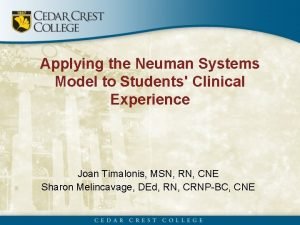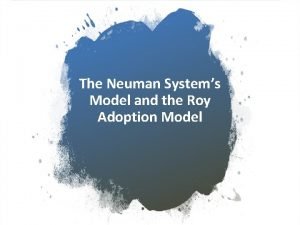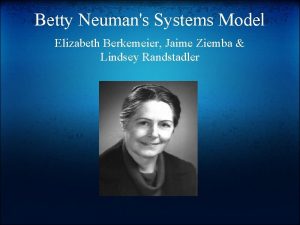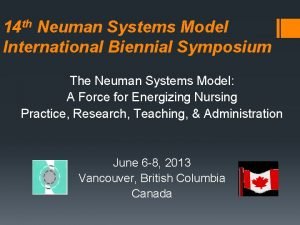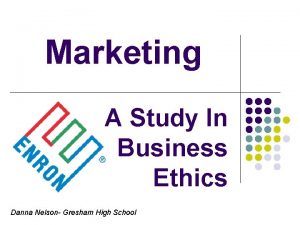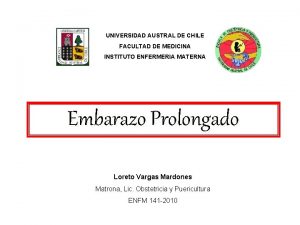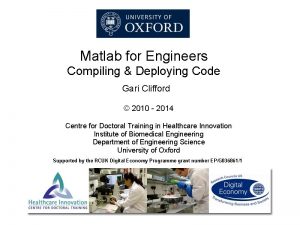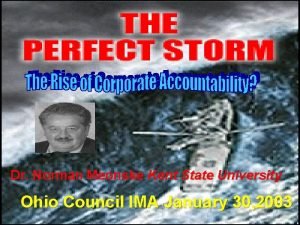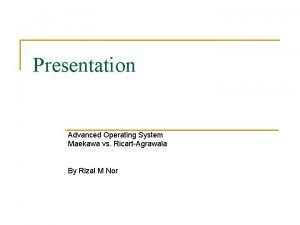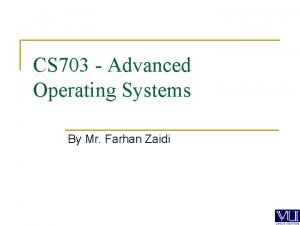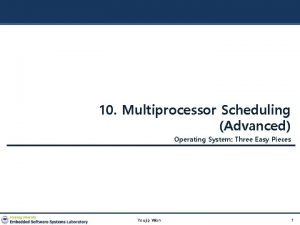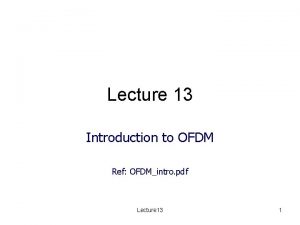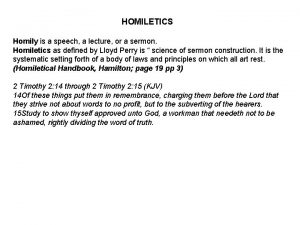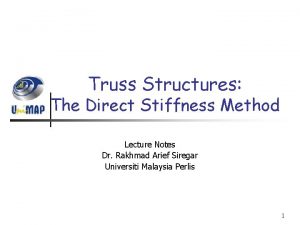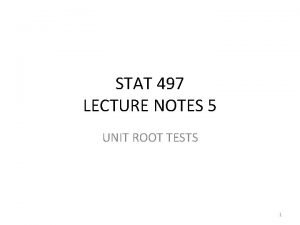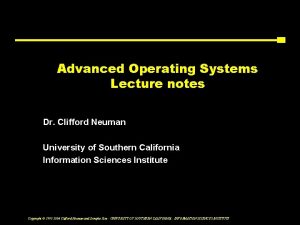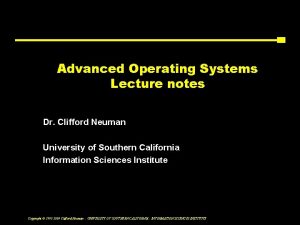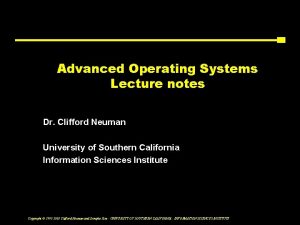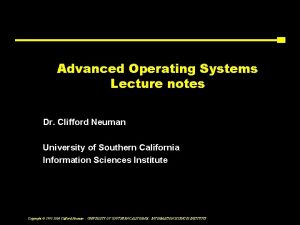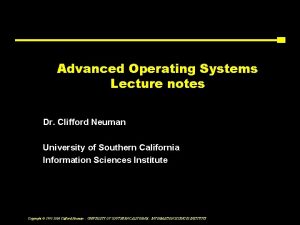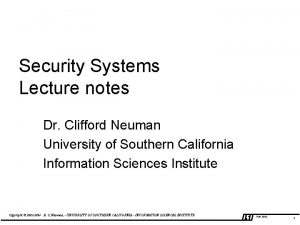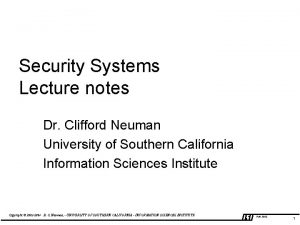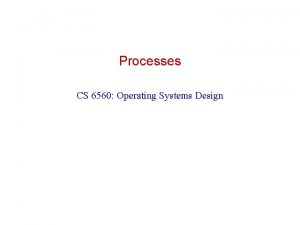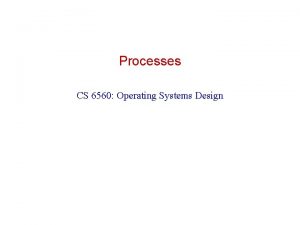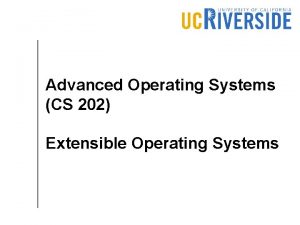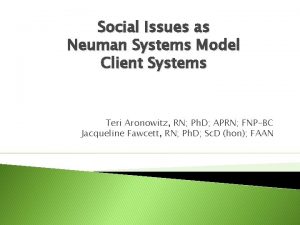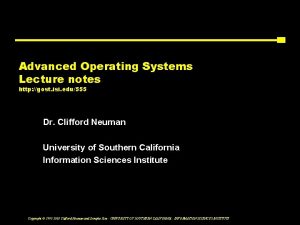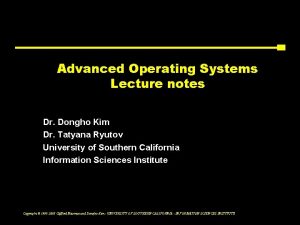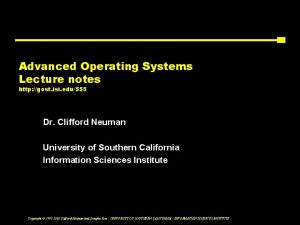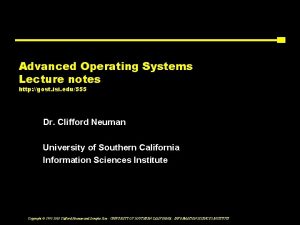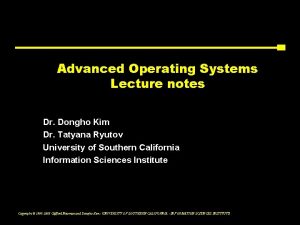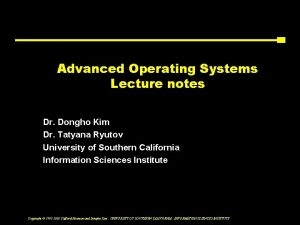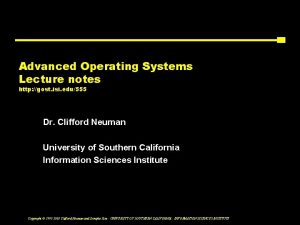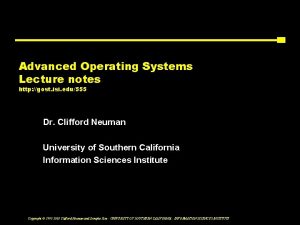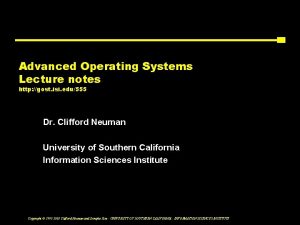Advanced Operating Systems Lecture notes Dr Clifford Neuman





























































- Slides: 61

Advanced Operating Systems Lecture notes Dr. Clifford Neuman University of Southern California Information Sciences Institute Copyright © 1995 -2008 Clifford Neuman - UNIVERSITY OF SOUTHERN CALIFORNIA - INFORMATION SCIENCES INSTITUTE

CSci 555: Advanced Operating Systems Lecture 4 – September 19 2008 Naming and Binding Dr. Clifford Neuman University of Southern California Information Sciences Institute Copyright © 1995 -2008 Clifford Neuman - UNIVERSITY OF SOUTHERN CALIFORNIA - INFORMATION SCIENCES INSTITUTE

CSci 555: Advanced Operating Systems Lecture 5 – September 26 2008 Ubiquitous and Mobile Computing Dr. Clifford Neuman University of Southern California Information Sciences Institute Copyright © 1995 -2008 Clifford Neuman - UNIVERSITY OF SOUTHERN CALIFORNIA - INFORMATION SCIENCES INSTITUTE

New Computing Environments v. Ubiquitous and Pervasive Computing q Including Sensor Nodes q Managing Devices v. Mobile computing q Portable Devices Copyright © 1995 -2008 Clifford Neuman - UNIVERSITY OF SOUTHERN CALIFORNIA - INFORMATION SCIENCES INSTITUTE

Characteristics v. Low power availability v. Constrained resources v. Transient relationships v. Ad-hoc deployment v. Peer to Peer relationships v. Weakly managed v. Context aware Copyright © 1995 -2008 Clifford Neuman - UNIVERSITY OF SOUTHERN CALIFORNIA - INFORMATION SCIENCES INSTITUTE

Ubiquitous computing v. According to Mark Weiser at Xerox: q Transparent computing is the ultimate goal q Computers should disappear into the background q Computation becomes part of the environment Copyright © 1995 -2008 Clifford Neuman - UNIVERSITY OF SOUTHERN CALIFORNIA - INFORMATION SCIENCES INSTITUTE

Ubiquitous Computing v Computing everywhere q Desktop, Laptop, Palmtop q Cars, Cell phones q Shoes, Clothing, Walls (paper / paint) v Connectivity everywhere q Broadband q Wireless v Mobile everywhere q Users move around q Disposable devices Copyright © 1995 -2008 Clifford Neuman - UNIVERSITY OF SOUTHERN CALIFORNIA - INFORMATION SCIENCES INSTITUTE

Ubiquitous Computing v. Structure q q q Resource and service discovery critical User location an issue Interface discovery Disconnected operation Ad-hoc organization v. Security q q Small devices with limited power Intermittent connectivity v. Agents v. Sensor Networks Copyright © 1995 -2008 Clifford Neuman - UNIVERSITY OF SOUTHERN CALIFORNIA - INFORMATION SCIENCES INSTITUTE

Mobile Computing v. Often managed devices q Cell phones q PDA’s q Subscription Services Copyright © 1995 -2008 Clifford Neuman - UNIVERSITY OF SOUTHERN CALIFORNIA - INFORMATION SCIENCES INSTITUTE

Ad-hoc Networking v. Peer-to-peer of network routing v. Transient devices v. Issues: q Discovery q Security q Power v. Examples: q Many Sensor Networks Copyright © 1995 -2008 Clifford Neuman - UNIVERSITY OF SOUTHERN CALIFORNIA - INFORMATION SCIENCES INSTITUTE

Source: ISI & DARPA PAC/C Program Communication/Computation Technology Projection Assume: 10 kbit/sec. Radio, 10 m range. Large cost of communications relative to computation continues (source – talk by Deborah Estrin) Copyright © 1995 -2008 Clifford Neuman - UNIVERSITY OF SOUTHERN CALIFORNIA - INFORMATION SCIENCES INSTITUTE

Active Badges v. Provides location information and one or more buttons v. Simple interface q Controlled access q Carries context § Two way, device knows where your are, and your location knows you are present § Moves your environment Copyright © 1995 -2008 Clifford Neuman - UNIVERSITY OF SOUTHERN CALIFORNIA - INFORMATION SCIENCES INSTITUTE

In-Network Processing v. Communication is expensive, computing less-so, so pre-process to reduce data sent. v. Send information, not-data. v. Requires more knowledge at the edges so that query can be distributed. v. Intermediate nodes correlate and agregate results. Copyright © 1995 -2008 Clifford Neuman - UNIVERSITY OF SOUTHERN CALIFORNIA - INFORMATION SCIENCES INSTITUTE

Directed Diffusion v. Publish/Subscribe model v. Data named, not nodes v. But what are the implications q discussion Copyright © 1995 -2008 Clifford Neuman - UNIVERSITY OF SOUTHERN CALIFORNIA - INFORMATION SCIENCES INSTITUTE

A Taxonomy v. Approaches/Products/Devices differ by placement/nature of: q Management q Storage q Computing q Communication q Context maintenance q Authority Copyright © 1995 -2008 Clifford Neuman - UNIVERSITY OF SOUTHERN CALIFORNIA - INFORMATION SCIENCES INSTITUTE

Classes v. Mobile Terminals v. Passive devices v. Personal Devices v. Remote Sensors/Actuators v. Communicating Devices v. Sensor Networks Copyright © 1995 -2008 Clifford Neuman - UNIVERSITY OF SOUTHERN CALIFORNIA - INFORMATION SCIENCES INSTITUTE

Examples v. Cell Phones vi-phone v. PDA v. Home automation v. Proximity cards v. Laptop computer v. In Vehicle networks v. Active Badges Copyright © 1995 -2008 Clifford Neuman - UNIVERSITY OF SOUTHERN CALIFORNIA - INFORMATION SCIENCES INSTITUTE

CSci 555: Advanced Operating Systems Lecture 6 – October 3, 2008 Security Concepts, Distributed Systems ADVANCE SLIDES Dr. Clifford Neuman University of Southern California Information Sciences Institute Copyright © 1995 -2008 Clifford Neuman - UNIVERSITY OF SOUTHERN CALIFORNIA - INFORMATION SCIENCES INSTITUTE

Security Goals v. Confidentiality q inappropriate information is not disclosed v. Integrity q Authenticity of document q That it hasn’t changed v. Availability q the ability of authorized entities to use the information or resource Copyright © 1995 -2008 Clifford Neuman - UNIVERSITY OF SOUTHERN CALIFORNIA - INFORMATION SCIENCES INSTITUTE

System Security: Terminology v vulnerability is a weakness in the system that might be exploited to cause loss or harm. v threat is a potential violation of security v attack is the actual attempt to violate security. It is the manifestation of the threat q Interception q Modification q Disruption v security policy defines what is and is not allowed v security mechanism is a method or tool for enforcing security policy q Prevention q Detection q Reaction Copyright © 1995 -2008 Clifford Neuman - UNIVERSITY OF SOUTHERN CALIFORNIA - INFORMATION SCIENCES INSTITUTE

Basic Security Services Protection Authentication Access Control, Authorization Accounting Payment Audit Assurance Privacy Policy Copyright © 1995 -2008 Clifford Neuman - UNIVERSITY OF SOUTHERN CALIFORNIA - INFORMATION SCIENCES INSTITUTE

Security Models v. Discretionary Access Control q Users have complete control over his/her resources v. Mandatory Access Control q q Administrators decide what you have access to as well as what you can give access to (as opposed to discretionary access control). Users must deal with not having control over how they use their own resources. Copyright © 1995 -2008 Clifford Neuman - UNIVERSITY OF SOUTHERN CALIFORNIA - INFORMATION SCIENCES INSTITUTE

Security Policy v. Access Matrix q implemented as: § Capabilities or § Access Control list Copyright © 1995 -2008 Clifford Neuman - UNIVERSITY OF SOUTHERN CALIFORNIA - INFORMATION SCIENCES INSTITUTE

Access Control Lists v. Advantages q Easy to see who has access q Easy to change/revoke access v. Disadvantages q Time consuming to check access v. Extensions to ease management q Groups q EACLs Copyright © 1995 -2008 Clifford Neuman - UNIVERSITY OF SOUTHERN CALIFORNIA - INFORMATION SCIENCES INSTITUTE

Extended Access Control Lists v. Conditional authorization q Implemented as restrictions on ACL entries and embedded as restrictions in authentication and authorization credentials Copyright © 1995 -2008 Clifford Neuman - UNIVERSITY OF SOUTHERN CALIFORNIA - INFORMATION SCIENCES INSTITUTE

Example Conditions v Authentication method specifies mechanisms suitable for authentication. v Payment specifies currency and amount. v Time time periods expressed as time of day or days of week when access is granted. v Location access is granted to principals connecting from specific hosts. v Notification enables automatic generation of notification messages. v Audit enables automatic generation of application level audit data. v System Threat Level specifies system threat level, e. g. , high, medium or low. Copyright © 1995 -2008 Clifford Neuman - UNIVERSITY OF SOUTHERN CALIFORNIA - INFORMATION SCIENCES INSTITUTE

Capabilities v. Advantages Easy and efficient to check access q Easily propagated q v. Disadvantages Hard to protect capabilities q Easily propagated q Hard to revoke q v. Hybrid approach q EACL’s/proxies Copyright © 1995 -2008 Clifford Neuman - UNIVERSITY OF SOUTHERN CALIFORNIA - INFORMATION SCIENCES INSTITUTE

Protecting capabilities v. Stored in TCB q Only protected calls manipulate v. Limitations ? q Works in centralized systems v. Distributed Systems q Tokens with random or special coding q Possibly protect through encryption q How does Amoeba do it? (claimed) Copyright © 1995 -2008 Clifford Neuman - UNIVERSITY OF SOUTHERN CALIFORNIA - INFORMATION SCIENCES INSTITUTE

Network Threats q. Unauthorized release of data q. Unauthorized modification of data q. Impersonation (spurious association initiation) q. Denial of use q. Traffic analysis v. Attacks may be q. Active or passive Copyright © 1995 -2008 Clifford Neuman - UNIVERSITY OF SOUTHERN CALIFORNIA - INFORMATION SCIENCES INSTITUTE

Likely points of attack (location) Copyright © 1995 -2008 Clifford Neuman - UNIVERSITY OF SOUTHERN CALIFORNIA - INFORMATION SCIENCES INSTITUTE

Likely points of attack (module) v Against the protocols q Sniffing for passwords and credit card numbers q Interception of data returned to user q Hijacking of connections v Against the server q The commerce protocol is not the only way in q Once an attacker is in, all bets are off v Against the client’s system q You have little control over the client’s system Copyright © 1995 -2008 Clifford Neuman - UNIVERSITY OF SOUTHERN CALIFORNIA - INFORMATION SCIENCES INSTITUTE

Network Attacks C S Attacker Eavesdropping Listening for passwords or credit card numbers Message stream modification Changing links and data returned by server Hijacking Killing client and taking over connection Copyright © 1995 -2008 Clifford Neuman - UNIVERSITY OF SOUTHERN CALIFORNIA - INFORMATION SCIENCES INSTITUTE

Network Attack Countermeasures C S Attacker Don’t send anything important Not everything needs to be protected Encryption For everything else Mechanism limited by client side software Copyright © 1995 -2008 Clifford Neuman - UNIVERSITY OF SOUTHERN CALIFORNIA - INFORMATION SCIENCES INSTITUTE

Encryption for confidentiality and integrity v. Encryption used to scramble data PLAINTEXT CIPHERTEXT PLAINTEXT + + (KEY) ENCRYPTION (KEY) DECRYPTION Copyright © 1995 -2008 Clifford Neuman - UNIVERSITY OF SOUTHERN CALIFORNIA - INFORMATION SCIENCES INSTITUTE

Authentication v. Proving knowledge of encryption key q Nonce = Non repeating value {Nonce or timestamp}Kc C S Copyright © 1995 -2008 Clifford Neuman - UNIVERSITY OF SOUTHERN CALIFORNIA - INFORMATION SCIENCES INSTITUTE

Today’s security deployment v Most of the deployment of security services today handles the easy stuff, implementing security at a single point in the network, or at a single layer in the protocol stack: q Firewalls, VPN’s q IPSec q SSL v Unfortunately, security isn’t that easy. It must be better integrated with the application. q At the level at which it must ultimately be specified, security policies pertain to application level objects, and identify application level entities (users). Copyright © 1995 -2008 Clifford Neuman - UNIVERSITY OF SOUTHERN CALIFORNIA - INFORMATION SCIENCES INSTITUTE

Conclusion: Integration is hard to do v The majority of applications were not being modified to use security services. q In fact, the only widespread interoperable integration of security services with applications was SSL integration with the web, and SSL is used primarily as a confidentiality mechanism and only rarely for user authentication. Copyright © 1995 -2008 Clifford Neuman - UNIVERSITY OF SOUTHERN CALIFORNIA - INFORMATION SCIENCES INSTITUTE

Conclusion: Integration is hard to do v The reason q Integration with applications involved many changes: § Multiple calls to GSS-API or other authentication interfaces § Calls to decide what the user is authorized to do – Home grown policy databases or protocol extensions requiring even more calls to complete. § Custom integration with other security services – Confidentiality, integrity, payment, audit Copyright © 1995 -2008 Clifford Neuman - UNIVERSITY OF SOUTHERN CALIFORNIA - INFORMATION SCIENCES INSTITUTE

Focus on Authorization v Focusing on authorization and the management of policies used in the authorization decision. q Not really new - this is a reference monitor. q Applications shouldn’t care about authentication or identity. § Separate policy from mechanism q Authorization may be easier to integrate with applications. q Hide the calls to the key management and authentication functions. Copyright © 1995 -2008 Clifford Neuman - UNIVERSITY OF SOUTHERN CALIFORNIA - INFORMATION SCIENCES INSTITUTE

Key distribution v. Conventional cryptography q Single key shared by both parties v. Public Key cryptography q Public key published to world q Private key known only by owner v. Third party certifies or distributes keys q Certification infrastructure q Authentication Copyright © 1995 -2008 Clifford Neuman - UNIVERSITY OF SOUTHERN CALIFORNIA - INFORMATION SCIENCES INSTITUTE

Kerberos Third-party authentication service q Distributes session keys for authentication, confidentiality, and integrity KDC TGS 3. Tgs. Req 2. T+{Reply}Kc 1. Req 4. Ts+{Reply}Kt C 5. Ts + {ts}Kcs S Copyright © 1995 -2008 Clifford Neuman - UNIVERSITY OF SOUTHERN CALIFORNIA - INFORMATION SCIENCES INSTITUTE

Global Authentication Service v Pair-wise trust in hierarchy q Name is derived from path followed q Shortcuts allowed, but changes name q Exposure of path is important for security v Compared to Kerberos q Transited field in Kerberos - doesn’t change name v Compared with X. 509 q X. 509 has single path from root q X. 509 is for public key systems v Compared with PGP q PGP evaluates path at end, but may have name conflicts Copyright © 1995 -2008 Clifford Neuman - UNIVERSITY OF SOUTHERN CALIFORNIA - INFORMATION SCIENCES INSTITUTE

Capability Based Systems - Amoeba “Authentication not an end in itself” v Theft of capabilities an issue q Claims about no direct access to network q Replay an issue v Modification of capabilities a problem q One way functions provide a good solution v Where to store capabilities for convenience q In the user-level naming system/directory q 3 columns v Where is authentication in Amoeba q To obtain initial capability Copyright © 1995 -2008 Clifford Neuman - UNIVERSITY OF SOUTHERN CALIFORNIA - INFORMATION SCIENCES INSTITUTE

Capability Directories in Amoeba Copyright © 1995 -2008 Clifford Neuman - UNIVERSITY OF SOUTHERN CALIFORNIA - INFORMATION SCIENCES INSTITUTE

Distributed Authorization v It must be possible to maintain authorization information separate from the end servers q q q Less duplication of authorization database Less need for specific prior arrangement Simplified management v Based on restricted proxies which support q q Authorization servers Group Servers Capabilities Delegation Copyright © 1995 -2008 Clifford Neuman - UNIVERSITY OF SOUTHERN CALIFORNIA - INFORMATION SCIENCES INSTITUTE

CSci 555: Advanced Operating Systems Lecture 6 – October 5 2007 PRELIMINARY SLIDES Trusted Computing and Virtualization Dr. Clifford Neuman University of Southern California Information Sciences Institute Copyright © 1995 -2008 Clifford Neuman - UNIVERSITY OF SOUTHERN CALIFORNIA - INFORMATION SCIENCES INSTITUTE

Security Architectures v. DSSA q Delegation is the important issue § Workstation can act as user § Software can act as workstation - if given key § Software can act as developer - if checksum validated Complete chain needed to assume authority q Roles provide limits on authority - new sub-principal v Proxies - Also based on delegation q Limits on authority explicitly embedded in proxy q Works well with access control lists q Copyright © 1995 -2008 Clifford Neuman - UNIVERSITY OF SOUTHERN CALIFORNIA - INFORMATION SCIENCES INSTITUTE

Next Generation Secure Computing Base -> Longhorn -> Vista v. Secure booting provides known hardware and OS software base. v. Security Kernel in OS provides assurance about the application. v. Security Kernel in application manages credentials granted to application. v. Security servers enforce rules on what software they will interact with. Copyright © 1995 -2008 Clifford Neuman - UNIVERSITY OF SOUTHERN CALIFORNIA - INFORMATION SCIENCES INSTITUTE

Hardware Requirements for Trusted Computing v. How do we know what software is running? q Exercise: Suppose a virus infected our application. q Suppose we were running a hacked kernel. q Suppose we were running in a virtual machine. q Suppose someone replaced our hardware with something similar, but with special operations. Copyright © 1995 -2008 Clifford Neuman - UNIVERSITY OF SOUTHERN CALIFORNIA - INFORMATION SCIENCES INSTITUTE

A basis step for trust v. The Hardware must be secure. q And it must be able to prove that it has not been modified or replaced. q This requires special keys accessible only to the hardware. q It requires tamper resistance that destroys the key if someone tries to open the chip. q (we also need validation of the hardware implementation) Copyright © 1995 -2008 Clifford Neuman - UNIVERSITY OF SOUTHERN CALIFORNIA - INFORMATION SCIENCES INSTITUTE

But this is an OS class v. The OS must be secure q And it must be able to prove that it has not been modified or replaced. q This requires special keys accessible to OS. § These keys are provided when booted. § They are bound to a checksum. § They may be managed in hardware or by the OS itself. q What does this protect against? Copyright © 1995 -2008 Clifford Neuman - UNIVERSITY OF SOUTHERN CALIFORNIA - INFORMATION SCIENCES INSTITUTE

What does the OS do v. The OS must perform special functions q Must provide certified keys for the applications (as the HW did for the OS). q The OS must protect itself, and its own keys – so that malware or other users can not act as the OS. q The OS must protect process from one another. Some functions may require stronger separation than typically provided today. q The Trusted Applications themselves must similarly application specific protections to the data they manipulate. Copyright © 1995 -2008 Clifford Neuman - UNIVERSITY OF SOUTHERN CALIFORNIA - INFORMATION SCIENCES INSTITUTE

This helps to contain breaches v. But it doesn’t prevent breaches. q A buggy OS can still be compromised. q Bugs in applications still leave vulnerabilities. q But one can at least be more sure about what version of software one is communicating with. Copyright © 1995 -2008 Clifford Neuman - UNIVERSITY OF SOUTHERN CALIFORNIA - INFORMATION SCIENCES INSTITUTE

Virtualization v. Operating Systems are all about virtualization q One of the most important function of a modern operating system is managing virtual address spaces. q But most operating systems do this for applications, not for other OSs. Copyright © 1995 -2008 Clifford Neuman - UNIVERSITY OF SOUTHERN CALIFORNIA - INFORMATION SCIENCES INSTITUTE

Virtualization of the OS v. Some have said that all problems in computer science can be handled by adding a later of indirection. q Others have described solutions as reducing the problem to a previously unsolved problem. v. Virtualization of OS’s does both. q It provides a useful abstraction for running guest OS’s. q But the guest OS’s have the same problems as if they were running natively. Copyright © 1995 -2008 Clifford Neuman - UNIVERSITY OF SOUTHERN CALIFORNIA - INFORMATION SCIENCES INSTITUTE

What is the benefit of virtualization v. Management q You can running many more “machines” and create new ones in an automated manner. q This is useful for server farms. v. Separation q “Separate” machines provide a fairly strong, though coarse grained level of protection. q Because the isolation can be configured to be almost total, there are fewer special cases or management interfaces to get wrong. Copyright © 1995 -2008 Clifford Neuman - UNIVERSITY OF SOUTHERN CALIFORNIA - INFORMATION SCIENCES INSTITUTE

What makes virtualization hard v. Operating systems are usually written to assume that they run in privileged mode. v. The Hypervisor (the OS of OS’s) manages the guest OS’s as if they are applications. v. Some architecture provide more than two “Rings” which allows the guest OS to reside between the two states. q But there are still often assumptions in coding that need to be corrected in the guest OS. Copyright © 1995 -2008 Clifford Neuman - UNIVERSITY OF SOUTHERN CALIFORNIA - INFORMATION SCIENCES INSTITUTE

Managing Virtual Resource v. Page faults typically trap to the Hypervisor (host OS). q Issues arise from the need to replace page tables when switching between guest OS’s. q Xen places itself in the Guest OS’s first region of memory so that the page table does not need to be rewitten for traps to the Hypervisor. v. Disks managed as block devices allocated to guest OS’s, so that the Xen code to protect disk extents can be as simple as possible. Copyright © 1995 -2008 Clifford Neuman - UNIVERSITY OF SOUTHERN CALIFORNIA - INFORMATION SCIENCES INSTITUTE

Partitioning of Resources v. Fixed partitioning of resources makes the job of managing the Guest OS’s easier, but it is not always the most efficient way to partition. q Resources unused by one OS (CPU, Memory, Disk) are not available to others. v. But fixed provisioning prevents use of resources in one guest OS from effecting performance or even denying service to applications running in other guest OSs. Copyright © 1995 -2008 Clifford Neuman - UNIVERSITY OF SOUTHERN CALIFORNIA - INFORMATION SCIENCES INSTITUTE

The Security of Virtualization v+++ Isolation and protection between OS’s can be simple (and at a very coarse level of granularity). v+++ This coarse level of isolation may be an easier security abstraction to conceptualize than the finer grained policies typically encountered in OSs. v--- Some malware (Blue pill) can move the real OS into a virtual machine from within which the host OS (the Malware) can not be detected. Copyright © 1995 -2008 Clifford Neuman - UNIVERSITY OF SOUTHERN CALIFORNIA - INFORMATION SCIENCES INSTITUTE

Virtualization and Trusted Computing v. The separation provided by virtualization may be just what is needed to keep data managed by trusted applications out of the hands of other processes. v. But a trusted Guest OS would have to make sure the data is protected on disk as well. Copyright © 1995 -2008 Clifford Neuman - UNIVERSITY OF SOUTHERN CALIFORNIA - INFORMATION SCIENCES INSTITUTE
 Clifford neuman rate my professor
Clifford neuman rate my professor Operating systems lecture notes
Operating systems lecture notes 01:640:244 lecture notes - lecture 15: plat, idah, farad
01:640:244 lecture notes - lecture 15: plat, idah, farad Advanced inorganic chemistry lecture notes
Advanced inorganic chemistry lecture notes Sbar copd
Sbar copd Neuman systems model case study
Neuman systems model case study Neuman's systems theory
Neuman's systems theory Using the neuman systems model for best practices
Using the neuman systems model for best practices Thick description example
Thick description example What happened enron
What happened enron Clifford consulting and research
Clifford consulting and research Danna nelson fun and dying
Danna nelson fun and dying Gwen clifford
Gwen clifford Clifford postermino
Clifford postermino John smith coca cola
John smith coca cola Clifford sifton open door policy
Clifford sifton open door policy Síndrome de postmadurez de clifford
Síndrome de postmadurez de clifford Hammersley-clifford
Hammersley-clifford Stephen j poplawski
Stephen j poplawski Millivoltage
Millivoltage Charlie clifford
Charlie clifford Gari clifford
Gari clifford Immigration lawyer charlton
Immigration lawyer charlton Va form 21p-0969 income and asset statement
Va form 21p-0969 income and asset statement Cliff baxter
Cliff baxter Clifford robinson md
Clifford robinson md Ricart-agrawala algorithm code in java
Ricart-agrawala algorithm code in java Advanced operating system
Advanced operating system Multiprocessor scheduling in operating system
Multiprocessor scheduling in operating system Project procurement management lecture notes
Project procurement management lecture notes Theology proper lecture notes
Theology proper lecture notes Advantages of government accounting
Advantages of government accounting 4 p's software engineering
4 p's software engineering Electricity and magnetism lecture notes
Electricity and magnetism lecture notes Classical mechanics
Classical mechanics Physical science lecture notes
Physical science lecture notes Power system dynamics and stability lecture notes
Power system dynamics and stability lecture notes Microbial physiology and metabolism lecture notes
Microbial physiology and metabolism lecture notes Application of mechatronics ppt
Application of mechatronics ppt Limits fits and tolerances
Limits fits and tolerances Financial engineering lecture notes
Financial engineering lecture notes Bipolar junction transistor notes
Bipolar junction transistor notes Software engineering lecture notes
Software engineering lecture notes Introduction to ofdm
Introduction to ofdm Land use planning lecture notes
Land use planning lecture notes Project quality management lecture notes
Project quality management lecture notes Lecture notes on homiletics
Lecture notes on homiletics Foundation engineering lecture notes
Foundation engineering lecture notes Image processing lecture notes
Image processing lecture notes Intermediate microeconomics lecture notes
Intermediate microeconomics lecture notes Cloud computing lecture
Cloud computing lecture Decision theory lecture notes
Decision theory lecture notes Polynomial regression least squares
Polynomial regression least squares Fundamental deviation table
Fundamental deviation table Stiffness matrix method lecture notes
Stiffness matrix method lecture notes Graphical method of flood routing
Graphical method of flood routing Unit root test lecture notes
Unit root test lecture notes Shape memory alloys lecture notes
Shape memory alloys lecture notes Notes on research methods
Notes on research methods Financial institutions and markets lecture notes ppt
Financial institutions and markets lecture notes ppt Physics 101 lecture notes pdf
Physics 101 lecture notes pdf Om 306
Om 306




